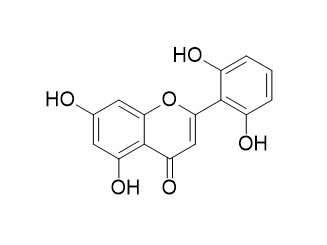2',5,6',7-Tetrahydroxyflavone
2',5,6',7-Tetrahydroxyflavone inhibited hepatic testosterone 6beta-hydroxylation (CYP3A4) activity with a IC50 of 7.8 microM.
Inquire / Order:
manager@chemfaces.com
Technical Inquiries:
service@chemfaces.com
Tel:
+86-27-84237783
Fax:
+86-27-84254680
Address:
1 Building, No. 83, CheCheng Rd., Wuhan Economic and Technological Development Zone, Wuhan, Hubei 430056, PRC
Providing storage is as stated on the product vial and the vial is kept tightly sealed, the product can be stored for up to
24 months(2-8C).
Wherever possible, you should prepare and use solutions on the same day. However, if you need to make up stock solutions in advance, we recommend that you store the solution as aliquots in tightly sealed vials at -20C. Generally, these will be useable for up to two weeks. Before use, and prior to opening the vial we recommend that you allow your product to equilibrate to room temperature for at least 1 hour.
Need more advice on solubility, usage and handling? Please email to: service@chemfaces.com
The packaging of the product may have turned upside down during transportation, resulting in the natural compounds adhering to the neck or cap of the vial. take the vial out of its packaging and gently shake to let the compounds fall to the bottom of the vial. for liquid products, centrifuge at 200-500 RPM to gather the liquid at the bottom of the vial. try to avoid loss or contamination during handling.
Plant Cell Physiol.2018, 59(1):128-141
Pharmacological Reports2020, 1-9
Evid Based Complement Alternat Med.2016, 2016:4357656
FASEB J.2019, 33(2):2026-2036
J Anal Toxicol.2021, bkab015.
Egyptian Pharmaceutical Journal2024, epj_205_23.
Sustainability2021, 13(23),12981.
VNU J Science: Med.&Pharm. Sci.2024.2588-1132
Hum. Ecol. Res.2025, 63(2):165-174
Food Chem.2024, 452:139555.
Related and Featured Products
Planta Med. 2005 Sep;71(9):885-7.
Skullcapflavone I from Scutellaria baicalensis induces apoptosis in activated rat hepatic stellate cells.[Pubmed:
16206047 ]
The therapeutic goal in liver fibrosis is the reversal of fibrosis and the selective clearance by apoptosis of hepatic stellate cells (HSCs), which play a central role in liver fibrogenesis.
METHODS AND RESULTS:
In this study, the apoptotic effect of wogonin, oroxylin A,
2',5,6',7-Tetrahydroxyflavone, skullcapflavone I, and baicalein, isolated from the dried root of Scutellaria baicalensis, was investigated in activated rat HSCs, T-HSC/Cl-6 cells transformed with the Simian virus 40. Among the isolated compounds, skullcapflavone I (20 microM for 24 h) significantly induced apoptosis in activated rat HSCs while there was no change in the cell viability of hepatocytes. Skullcapflavone I increased caspase-3 and -9 activities accompanied by the proteolytic cleavage of poly(ADP-ribose) polymerase. Specific inhibitors of caspase-3 and caspase-9 prevented the apoptotic process induced by skullcapflavone I.
CONCLUSIONS:
From these results, skullcapflavone I from S. baicalensis selectively induced apoptosis in T-HSC/Cl-6 cells via caspase-3 and caspase-9 activation.
J Toxicol Environ Health A. 2002 Mar;65(5-6):373-81.
Effects of flavonoids isolated from Scutellariae radix on cytochrome P-450 activities in human liver microsomes.[Pubmed:
11936218 ]
A series of flavonoids isolated from Scutellariae radix were evaluated for their effects on cytochrome P-450 (CYP) activities in human liver microsomes.
METHODS AND RESULTS:
All flavonoids did not substantially inhibit pentoxyresorufin O-deethylation (CYP2B 1), mephenytoin 4-hydroxylation (CYP2C19), dextromethorphan O-demethylation (CYP2D6), and chlorzoxazone 6-hydroxylation (CYP2E1) activities (IC50: >50 microM). Baicalein and
2',5,6',7-Tetrahydroxyflavone inhibited hepatic testosterone 6beta-hydroxylation (CYP3A4) activity with a IC50 of 17.4 and 7.8 microM, respectively. Oroxylin A inhibited diclofenac 4-hydroxylation (CYP2C9) activity with a IC50 of 6.7 microM. In contrast, all flavonoids tested inhibited hepatic caffeine N'-demethylation (CYP1A2) with IC50 values ranging from 0.7 to 51.3 microM. Kinetic analysis revealed that the mechanism of inhibition varied according to the flavonoids.
CONCLUSIONS:
These results suggest that flavonoids tested are inhibitors of hepatic CYP1A2 and that the extracts of Scutellariae radix, widely used as a hepatoprotective agent, may protect the liver through the prevention of CYPIA2-induced metabolic activation of protoxicants.



